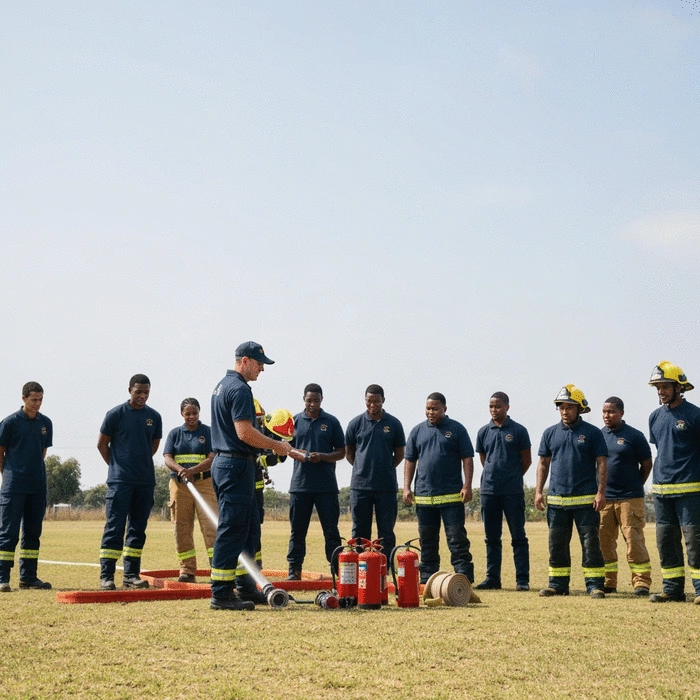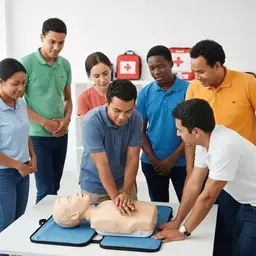What Training Entails?
- Fire safety principles
- Extinguisher types & use
- Emergency evacuation
- Basic first aid (fire)
Join the OHS Hub South Africa community for essential safety insights, compliance tips, and product updates.
Posted on: 2025-11-14
By: Thandiwe Mokoena
Did you know that investing in fire safety training can significantly reduce workplace injuries and property damage? Understanding how to respond effectively to fire emergencies is crucial for creating a safe environment. Let's explore the key insights from Basic Fire Fighting Training and how it can empower your workforce.
This visual highlights the crucial components and benefits of Basic Fire Fighting Training, along with essential regulations and career pathways.
As an occupational health and safety professional, I often emphasize the importance of Basic Fire Fighting Training in creating a safe workplace. This type of training equips employees with the crucial skills needed to respond effectively to fire emergencies. Understanding how to combat fires safely can drastically reduce the risk of injury and damage in various environments.
In South Africa, fire incidents can occur unexpectedly. Therefore, having a well-trained workforce is not just beneficial, it’s essential for maintaining workplace safety standards. Let’s delve deeper into what this training entails and why it’s so important.
Basic Fire Fighting Training is a practical course designed to teach individuals the fundamental skills required to handle fire emergencies. The training covers a variety of topics, including fire prevention techniques, correct usage of fire fighting equipment, and emergency response procedures. This course is tailored for various professionals, including those in high-risk sectors like construction and manufacturing. To ensure readiness for such demanding roles, individuals often need to meet specific physical health criteria, such as those required to obtain a fitness certificate for work.
By completing this training, participants gain a comprehensive understanding of how to manage fire risks effectively and respond appropriately to fire outbreaks.
The necessity of fire fighting training cannot be overstated. Having trained personnel in your organization can significantly enhance the overall safety culture. Here are some reasons why investing in fire fighting training is crucial:
Furthermore, when employees feel confident in their abilities to handle emergencies, it promotes a sense of community and trust within the workplace.
South Africa has established various fire safety regulations to ensure that workplaces are prepared for fire emergencies. These regulations are designed to protect employees and property, and they include guidelines on fire risk assessments, proper maintenance of fire safety equipment, and regular fire drills.
Understanding and implementing these regulations not only helps businesses comply with legal requirements but also fosters a culture of safety and preparedness.
Did you know? Regularly conducting fire drills not only helps in reinforcing the skills learned during training but also boosts employee confidence in handling emergencies. Make it a point to schedule these drills at least twice a year and include different scenarios to keep everyone prepared for any situation!
As we wrap up our discussion on fire fighting training, it's essential to recap the course requirements and certification needed to become a qualified firefighter. Understanding these requirements ensures that individuals are well-prepared to handle the demands of this crucial role.
First, educational qualifications typically include a basic high school diploma, while physical fitness standards require applicants to demonstrate stamina and strength. Additionally, you’ll need to pass any necessary background checks and comply with age restrictions, usually set at 18 years. This comprehensive approach ensures that all prospective firefighters are not only knowledgeable but also physically capable of performing their duties effectively.
Having these prerequisites in place helps streamline the training process and prepares candidates for the responsibilities they will face. With the right qualifications, you can confidently pursue your certification and take the first step toward a rewarding career in fire safety.
Choosing the right training provider is a critical decision in your fire fighting journey. Not all courses are created equal; hence, selecting an accredited institution can significantly impact the quality of your education. At OHS Hub South Africa, we emphasize the importance of partnering with reputable training organizations to ensure compliance with local regulations and best practices.
These factors will not only enhance your learning experience but also position you favorably in the job market. Remember, investing in quality training is investing in your future!
Community fire safety programs play an invaluable role in supplementing formal training. These programs often provide hands-on experience and foster a deeper understanding of fire prevention tactics. Engaging with local fire departments or community organizations can offer practical insights and real-world application of skills learned in the classroom.
By integrating community-based training, you not only enhance your skills but also contribute to the overall safety and preparedness of your community. This collaborative approach is a great way to solidify your commitment to fire safety and build meaningful connections in the field.
Ready to dive into fire fighting training? The first step is to research available courses and find the one that fits your needs. Start by visiting local training centers or checking out online resources that provide listings of accredited programs.
Taking action today will bring you closer to your goal of becoming a certified firefighter. Remember, every journey begins with a single step, so don’t hesitate to reach out to training providers for guidance!
As someone passionate about safety, I encourage you to consider a career in fire safety. This field offers not only the chance to protect lives but also the opportunity to make a meaningful impact in your community. Fire safety professionals are respected and valued, and the skills you gain can lead to diverse career paths.
Whether you aspire to work as a fire technician, safety officer, or instructor, the possibilities are endless. Embrace this rewarding journey, and remember that each step you take enhances not only your life but the lives of those around you!
Fire safety is a dynamic field with numerous growth opportunities. As you gain experience and certifications, you may find yourself eligible for advanced roles in fire management, safety training, or policy development. Continuous education and networking can open doors to leadership positions, and there’s always a need for passionate individuals committed to safety.
The journey doesn’t end with certification; it’s just the beginning! Equip yourself with knowledge, stay dedicated to your craft, and you’ll thrive in this essential profession.
Here is a quick recap of the important points discussed in the article:
Basic Fire Fighting Training is a practical course that teaches individuals fundamental skills for handling fire emergencies, including fire prevention, proper use of firefighting equipment, and emergency response procedures.
It is essential because it improves safety awareness, significantly reduces the risk of injury and property damage during a fire incident, and ensures compliance with legal fire safety regulations.
Key regulations include the Occupational Health and Safety Act (OHSA), National Building Regulations, and guidelines from the Fire Protection Association of Southern Africa (FPASA).
Requirements generally include a high school diploma or equivalent, passing physical fitness tests, being 18 years or older, and successfully completing background checks.
Community programs provide hands-on experience, opportunities for mentorship with experienced firefighters, access to local resources, and networking, which all complement formal training.



 How often do you consider the vital role that PPE gloves play in workplace safety? In industries ran
How often do you consider the vital role that PPE gloves play in workplace safety? In industries ran
 Are you aware that first aid training can be the difference between life and death in emergencies? U
Are you aware that first aid training can be the difference between life and death in emergencies? U
 As workplace safety becomes increasingly critical, understanding the role of drug screening can lead
As workplace safety becomes increasingly critical, understanding the role of drug screening can lead